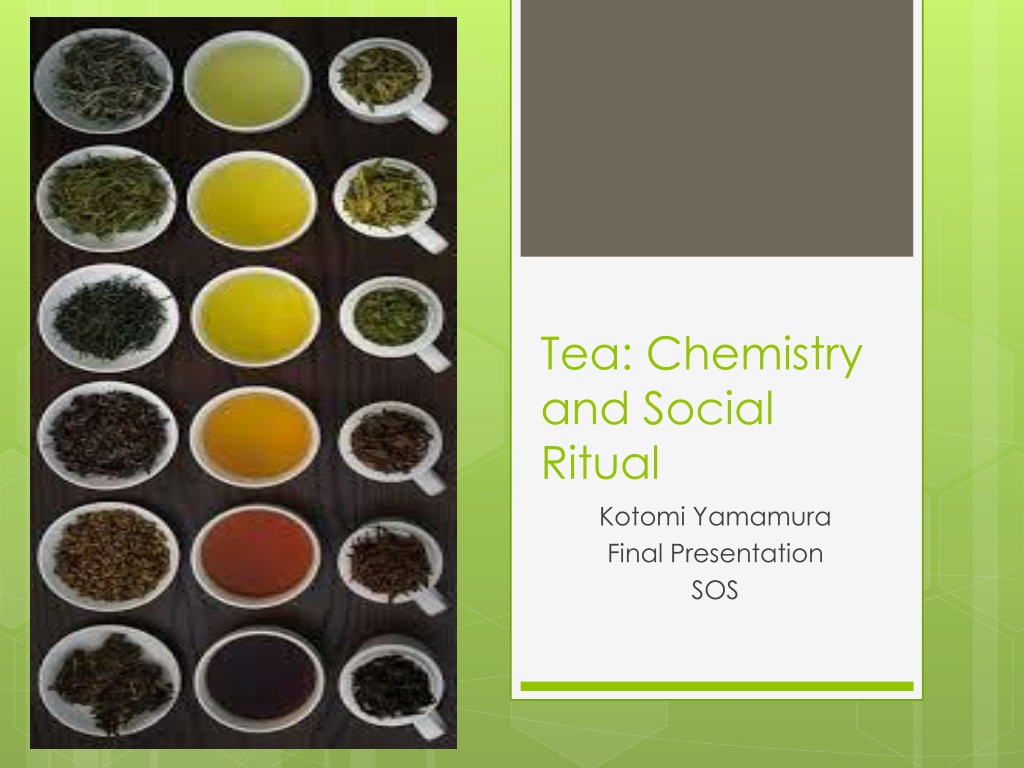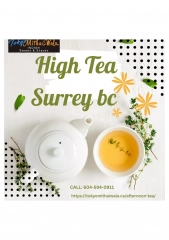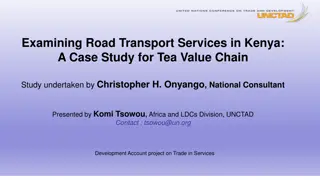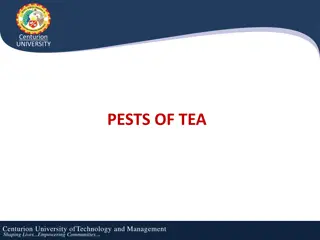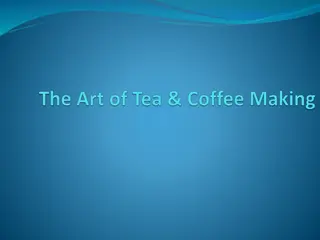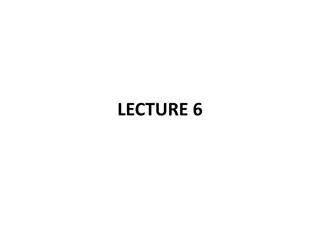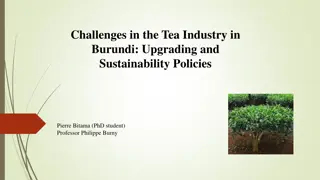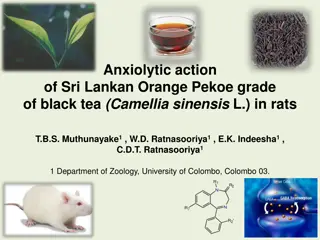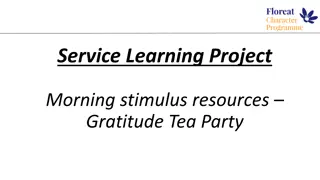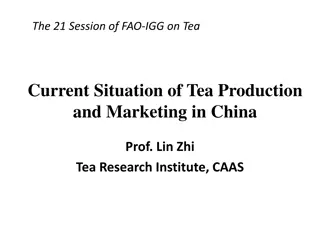Exploring the Chemistry and Culture of Tea: A Comprehensive Study
Delve into the intricate world of tea through its chemistry, processing techniques, types, and effects. Uncover the social rituals surrounding tea consumption and its diverse cultural significance. Enhance your knowledge with insights on oxidation, enzymatic transformations, and the health benefits of different tea varieties. From white and green teas to black and fermented Pu'er, this presentation offers a deep exploration into the fascinating realm of tea.
Download Presentation

Please find below an Image/Link to download the presentation.
The content on the website is provided AS IS for your information and personal use only. It may not be sold, licensed, or shared on other websites without obtaining consent from the author. Download presentation by click this link. If you encounter any issues during the download, it is possible that the publisher has removed the file from their server.
E N D
Presentation Transcript
Tea: Chemistry and Social Ritual Kotomi Yamamura Final Presentation SOS
ILC I will read portions of the book, Tea: a symposium on the pharmacology and psychological effects of tea; therapeutic effects of tea; Chemistry and applications of green tea; caffeinated beverages: health benefits, physiological effects and chemistry. Plus any additional media, books, or peer reviewed research papers that will support my ability to synthesize my research. I will write weekly e-journal posts to document my work, as well as, curate weekly tea tasting workshops where I will be able to share my research with my peers and faculty
Camellia sinensis Camellia sinensis variety sinensis China Tea
Camellia sinensis Camellia sinensis variety assamica Assam Tea
Categories of Tea Un-oxidized 1. White and Green Tea 2. Semi-oxidized Yellow and Oolong 3. Fully-oxidized Red/Black Tea and Pu er Only fermented tea is cooked Pu er
Tea Processing Picking Withering Rolling Drying Sorting and Grading Oxidation technique CTC (Cut Tear Curl)
Two general types of enzymatic transformation in tea 1. liberation of aroma molecules 2. Building of large molecules from small ones. The small molecules come from the tea leaf s abundant supply of three-ring phenolic compounds. Modifies, flavor, color, body, and physiological effects.
What is Oxidation The chemical process in which atoms lose elections, as when the material combines with oxygen. Oxidation of tea leaves
Enzymes, Polyphenol oxidase and peroxidase Wither/roll>cells damaged> Exposed to oxygen> Polyphenols in cell leaf mix with peroxidase and then with polyphenol oxidase=chemical reaction. Catechins are converted into flavanoids called theaflavins and thearubigins
What is a polyphenol? It is a compound containing more than one (poly)phenolic hydroxyl group
Theaflavin: Source of Yellow color in Yellow Tea and Oolong
Thearubigin: Source of red/brown color in Red/Black Tea and Pu er
Man as a practice, supplements, the pharmacological stimuli he seeks in beverages by psychological and social stimuli, which reinforce and accentuate these pharmacological stimuli. -Henry J.Klaunberg From, Tea: a symposium on the pharmacology and psychologic effects of tea
Related Art, Printmaking, and Wheel thrown pottery.
Bibliography 31358_monkeypickedoolongrtea_a.jpg (638 638). Accessed March 16, 2017. https://www.homenaturalcures.com/wp- content/uploads/31358_monkeypickedoolongrtea_a.jpg. 32258_earlgreytea_Hol16.jpg (1000 1000). Accessed March 16, 2017. http://demandware.edgesuite.net/sits_pod26/dw/image/v2/AAFV_PRD/on/demandware.st atic/-/Sites- Teavana_Master_Catalog/default/dw58701317/images/Product%20Images/Tea/32258_earl greytea_Hol16.jpg?sw=1000&sh=1000. Assamteaplant.jpg (400 300). Accessed March 16, 2017. http://www.assams.info/images/2008/05/assamteaplant.jpg. Camellia-Sinensis.jpg (1000 750). Accessed March 16, 2017. http://www.plantsrescue.com/wp-content/uploads/2014/09/Camellia-sinensis.jpg. Catechin - Google Search. Accessed March 16, 2017. https://www.google.com/search?q=catechin&source=lnms&tbm=isch&sa=X&sqi=2&ved=0 ahUKEwit8Nytx9rSAhXGLmMKHRO9ACQQ_AUIBygC&biw=960&bih=525#imgrc=x8J8J1bgB0Lr RM: Klaunberg, Henry J. A Symposium on the Pharmacology and the Physiological and Physiological Effects of Tea. Biological Sciences Foundation, 1955. Polyphenol - Google Search. Accessed March 16, 2017. https://www.google.com/search?q=polyphenol&source=lnms&tbm=isch&sa=X&ved=0ahUK Ewie9uHOx9rSAhVC52MKHfyYDZ8Q_AUICCgD&biw=960&bih=525#imgrc=qN0yAyrEaObZ_M: Tea Polyphenols - Google Search. Accessed March 16, 2017. https://www.google.com/search?q=the+phenolic+family&source=lnms&tbm=isch&sa=X&v ed=0ahUKEwjg7Nr5yNrSAhUO8GMKHeT_Dz4Q_AUIBigB&biw=960&bih=525#tbm=isch&q=tea +polyphenols&*&imgrc=bi_ULSCWlBoPjM: Tea Processing and Its Effects on Polyphenol Content - Google Search. Accessed March 16, 2017. https://www.google.com/search?q=tea+processing&source=lnms&tbm=isch&sa=X&sqi=2& ved=0ahUKEwjBsp2iydrSAhVQ_mMKHfY1D9sQ_AUIBigB&biw=1156&bih=595#tbm=isch&q=te a+processing+and+its+effects+on+polyphenol+content&*&imgrc=8qBfWex4lW_V7M: Theaflavin - Google Search. Accessed March 16, 2017. https://www.google.com/search?q=catechin&source=lnms&tbm=isch&sa=X&sqi=2&ved=0 ahUKEwit8Nytx9rSAhXGLmMKHRO9ACQQ_AUIBygC&biw=960&bih=525#tbm=isch&q=theafl avin&*&imgrc=fVl073tJv0TMuM:
